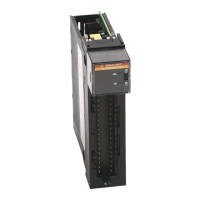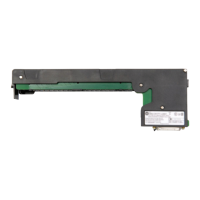70 Rockwell Automation Publication 1756-UM540E-EN-P - December 2017
Chapter 4 Temperature-sensing Analog Modules
Because these modules can each be used in various applications, differences exist
when a wire off condition is detected in each application. The table lists the
differences that occur when a wire off condition occurs in various applications.
Table 16 - Module Wire Off Conditions
Application Configuration Wire Off Condition Cause Resulting Module Behavior
Input Type = RTD
Sensor Type = Temperature or
Ohm
When using a 3-wire RTD device and any of the following exists:
• One wire is disconnected from any of the channel’s terminals.
• Wires are disconnected from any combination of terminals:
1756-IRT8I
– IN_x(+)/A
– IN_x(-)/B
– IN_x/RTD C
1756-IR12
– IN_x/A
– IN_x/B
– RTN_x/C
• All of the wires are disconnected from the channel.
With the 3-wire RTD device, the wire off condition is detected
within two seconds of wires getting disconnected.
The following occurs:
• Input data for the channel changes to the highest scaled temperature
value associated with the selected sensor type.
• The I.Ch[x].Overrange tag is set to 1.
x represents the channel number.
When using a 4-wire RTD device and any of the following exists:
• A wire is disconnected from only terminal IN_x(-)/B.
• Wires are disconnected from any combination of the channel’s
terminals, that is:
– IN_x(+)/A
– IN_x(-)/B
– IN_x/RTD C
– IN_x/RTD D
IMPORTANT: There is one combination exception that does not
apply.
A wire off condition is not detected when wires are
simultaneously disconnected from only IN_x/RTD C and
IN_x/RTD D terminals.
• All wires are disconnected from the module.
With the 4-wire RTD device, the wire off condition is detected
within five seconds of wires getting disconnected.
If bullet 1, the following occurs:
• Input data for the channel changes to the lowest scaled temperature
value associated with the selected sensor type.
• Th
e
I.Ch[x].Underrange tag is set to 1.
x represents the channel number.
If bullets 2 or 3, the following occurs:
• Input data for the channel changes to the highest scaled temperature
value associated with the selected sensor type.
• The I.Ch[x].Overrange tag is set to 1.
x represents the channel number.
Input Type = Thermocouple
Sensor Type = Temperature
A wire is disconnected from the module.
With the Thermocouple input type, the wire off condition is
detected within two seconds of wires getting disconnected.
When a Wire Off condition is detected from the ADC, it is delayed
by ~1 second to ensure it is a real condition. During that delay, the
Uncertain bit is set for the channel, but the Data is not forced to a
rail until the second has passed and the Wire Off has been
continuously maintained.
• Input data for the channel changes to the highest scaled temperature
value associated with the selected sensor type.
• The I.Ch[x].Overrange tag is set to 1.
x represents the channel number.
Input Type = Thermocouple
Sensor Type = mV
• Input data for the channel changes to the scaled value associated with
the overrange signal value.
• The I.Ch[x].Overrange tag is set to 1.
x represents the channel number.

